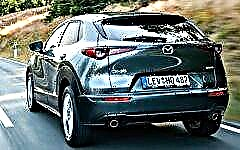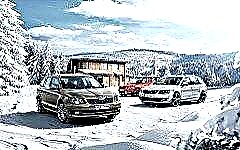
The most interesting facts about the history of the Skoda brand are in our review.
1. The most stylish

This is exactly what, the most original and stylistically consistent, is considered the brand name of the auto concern, patented in 1923.
The founders of the company initially had "Napoleonic plans" for the future, and therefore they not only victoriously named their first motorcycle "Slavia", but also depicted the emblem in the form of a knightly order.
When the company acquired the name Laurin & Klement, the emblem became less opulent, but still retained the monogram and laurel wreath that framing the letters.
The same "Indian theme" that has survived to this day first appeared in 1925, after a merger with local entrepreneur Emil Skoda. A servant from America worked in his house, who inspired the romantic image of Indians and freedom.
Although the second version bestows the authorship of the emblem on the commercial director Maglich, who sketched on a piece of paper an Indian head in a traditional headdress with feathers and placed it in a circle. The image was interpreted as follows: incessant production in the form of a circle, the accuracy of an arrow, vigilance and foresight, like the eye of an Indian, and feathers as a symbol of speed and progress.
Then the changes to the emblem were color, stylistic, the designers got rid of the pretentious wreath, and the modern emblem was redesigned in a new way: the head of the Indian became a gear symbolizing progress, the arrow turned into an innovation, and only the "eye" still speaks of the precision of the production process.
2. From curiosity to legend

Now the sporty character of Skoda cars is undeniable - countless awards and orders for rally models from the world's leading car manufacturers. And the chain of victories began with a curious situation during motorcycle races more than a century ago.
The designer of the company, which was then still called Laurin & Klement, decided to take part in the 1901 competition himself, having traveled from Paris to Berlin.
The motorcycle model developed for the race was so successful that the Czech participant set an absolute record.
However, it was not counted and entered into the historical chronicle for a banal reason - the high-speed Czech came to the finish line at 3 am, when all members of the jury were deeply asleep and could not fix the result.
However, this event became an incentive for further work on the sports characteristics of the vehicles produced. Skoda models favorably distinguished themselves from competitors in their adaptability to tracks of any quality, which, among other things, regularly made them winners of auto races in pre-revolutionary Russia.
3. Right rudder

All Skoda cars produced before the 40s had a right-hand drive. Even after the adoption of the Paris Convention, the Czech government was in no hurry to switch to a new type of movement until World War II broke out.
Hitler fiercely hated Great Britain and everything connected with it, including the original English right-hand traffic. With the advent of the Nazis to power, the very first orders in the occupied countries demanded a complete ban on right-hand drive vehicles.
The Czech Republic almost in a matter of hours had to change the traffic rules, make new signs and stop the established production of cars.
4. Rear-engine layout

In the photo: rear-engined Skoda model
In the modern automotive industry, you will no longer find a car with a rear-engined configuration, except perhaps on rare buses or sports cars such as the Porsche 911.
This design is different in that it shifts the center of gravity back, providing the car with accelerated acceleration, which explains its use in the racing field. However, it also caused a skid during sharp turns, when the driver released the gas pedal, and the rear wheels lost grip.
The leaders in the introduction of models with a rear-engined layout in the car market were precisely the Czech manufacturers, led by Skoda.
The new fashion began to be gradually adopted by American and German automakers, and then by the friendly Soviet Union.
By the 70s, the trend for such a design began to recede into the past, giving way to roomy and manageable front-wheel drive hatchbacks. And only Skoda could not accept the new trends for the longest time, continuing to place motors in the rear of the car until the 80s.
5. Skoda in the USSR

In the photo: Skoda-1201
In the 50s and 60s, the Soviet automobile trade would have experienced a severe crisis if Skoda had not saved it.
In those days, in our country, in principle, there was no production of small-tonnage vehicles, while the demand for them increased more and more. Auto repair shops, to the best of their ability, converted used "Victory" into pickups or vans, which only to a small extent solved the problem of a shortage of vehicles of this kind.
The first Czech “swallows” were Skoda-1201 and 1210, which were ordered for the system of public services, for the needs of laundries and dry cleaners, for the transportation of food products. Although these models were inferior to the domestic auto industry in terms of power units, they demonstrated their reliability, efficiency and practicality in everyday work.
The owners especially appreciated the significantly lower operating costs of Czech cars compared to Soviet models, which gave additional commercial benefits.
Successful experience of use served as an incentive for ordering new lots, now as ambulances for medical institutions. They differed from standard station wagons with a 2-leaf rear door and an extended rear overhang, and a special service base was organized for their maintenance.
The demand for Skoda was consistently high, and the cars, in turn, were invariably pleased with quality, safety and reliability.
However, after a total ban on the import car industry, including from some CMEA countries, Soviet enterprises had to replace their vehicle fleets with the products of the AZLK, which was gaining momentum. Thus, the last Skodas were brought into the Union in 1968, after which Czech models left our tracks until 1995.
6. Kodiaq or Kodiak

In the photo: Skoda Kodiaq 2016
It's rare for a car to boast such a mix of names as this gorgeous mid-size crossover unveiled in 2016.
The working name of the 5-seater model, which, thanks to the possibility of equipping with a third row of seats, can turn into a 7-seater, sounded like Snowman - Bigfoot.
Then there was an idea to devote a new development to the largest brown bear on the planet Kodiak, living on the island of the same name in Alaska. But the developers found this name too harsh, firstly, and, in addition, the word kodiak has appeared more than once in the automotive world.
For example, in 1983 the sports car shown at the Frankfurt Motor Show was named "bearish". The American pickup truck Chevrolet C-4500 Kodiak, whose history goes back more than one decade, bears the same name.
This is how the first 7-seater crossover Kodiaq in the range of Skoda was born, accommodating people of any height and size “in the gallery”.
The most spacious in the segment of C-class crossovers, it allows you to partially or completely remove the middle sofa, giving its passengers even more space. Thus, this model is several times superior to its "fellow tribesmen" both in external and internal dimensions.
7. People's car

In the photo: Skoda Octavia A7
Statistics show that Czech drivers prefer their own car industry. Moreover, they choose it not so much because of technical excellence, comfort or pricing policy, but more out of patriotic feelings and pride in their industry.
"Octavia" (Octavia) translates as "eighth" - this is exactly what this model became for the manufacturer at the end of the Second World War.
She replaced the rear-engined anachronisms in order to compete on a par with other European cars. The Czech company has already started close cooperation with Volkswagen, which spared no expense in order to rid its new division of the "socialist legacy".
A model called Octavia was already in Skoda's range between 1959-1971 and enjoyed steady demand.
Working on a new car, Czech specialists wanted to emphasize their long history and experience and pay respect to the past, and therefore they remembered this forgotten beautiful Latin name given to women.
The resulting car was exactly what was needed at that time: modern, discreet, simple, practical. In the late 90s, when biodesign was flourishing with might and main, the Czechs fundamentally created a look that made the model a classic, timeless and fashionable.
Even now, with the third generation Octavia already available, the demand for the legendary first modification is not decreasing.
Conclusion
Skoda has come a long way from making bicycles to iconic cars. Its history has had its ups and downs, mergers and dramatic changes that have tempered the character of the manufacturer and made it possible to produce models that are invariably relevant, in demand and reliable.

|| list |
- Most stylish
- From curiosity to legend
- Right rudder
- Rear-engine layout
- Skoda in the USSR
- Kodiaq or Kodiak
- People's car
Skoda











